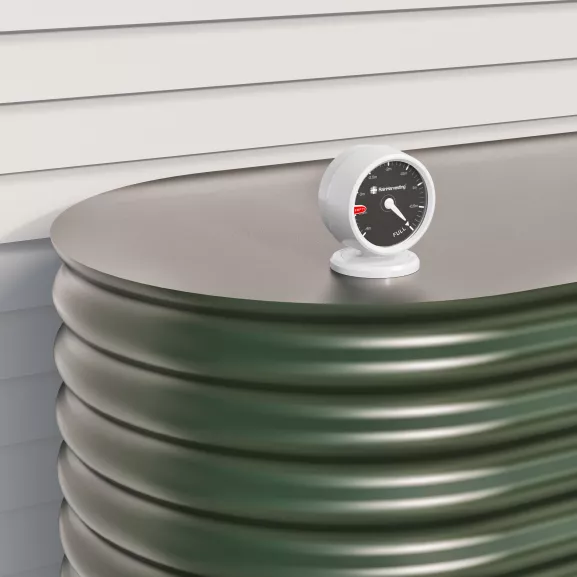For rainwater harvesting systems,Knowing exactly how much water you have available in your tank is not just convenient—it’s essential for effective water management.
Without accurate tank level information, homeowners face multiple challenges:
Unexpected shortages during dry periods
Overflow and waste during heavy rainfall
The inability to plan water usage effectively
This lack of visibility often leads to inefficient use of harvested rainwater and continued reliance on mains water even when stored rainwater is available.

Modern water monitoring systems
These are transforming how UK homeowners manage water, especially when paired with rainwater harvesting. These systems provide the critical tank level data needed to make informed decisions about water usage, maintenance, and conservation.
Why Tank Level Monitoring Matters
Preventing Unexpected Shortages
Without monitoring, many homeowners discover they’re out of harvested rainwater only when their systems run dry—often at the most inconvenient times. Real-time tank level data allows you to anticipate shortages before they occur, helping you prioritise usage or implement conservation measures during dry periods.
Maximising Collection Efficiency
Understanding your tank’s capacity utilisation helps you determine if your storage is adequate for your needs.
If your tanks frequently overflow during rainfall, you might need additional storage capacity.
Conversely, if they rarely fill completely, you may have oversized your system.
Planning Appropriate Usage
With accurate knowledge of available water, you can confidently plan water-intensive activities like garden irrigation or pressure washing when you have sufficient stored rainwater, rather than drawing from mains supply.
Detecting Leaks and System Issues
Unexplained decreases in water levels often indicate leaks or other system problems. Early detection through continuous monitoring can prevent water waste and potential property damage whilst saving on repair costs.
Seasonal Planning
Tank level history allows you to understand seasonal patterns in your water collection and usage, helping you adapt your water management strategy throughout the year to maximise self-sufficiency.
Smart Water Monitoring Technology
Core Components
Advanced Sensors: Precision float or pressure sensors track water levels and flow in rainwater tanks up to 10 metres tall, with accuracy down to 20mm.
User Interfaces: An intuitive smartphone app delivers insights, alerts, and control from anywhere with network coverage.
Key Capabilities
With smart tank gauges, homeowners can:
Monitor rainwater collection levels in real time across single or multiple tanks.
Receive custom alerts for sudden changes, flagging potential leaks or overuse.
Analyse historical usage patterns to optimise water habits.
These gauges are typically built with UV-resistant materials and powered by long-lasting AA batteries, making them durable and low-maintenance, requiring only occasional battery replacement or sensor cleaning.

Benefits for UK Homeowners
Reduced Water Bills
The Energy Saving Trust suggests that homes using rainwater harvesting with smart monitoring can cut mains water use by 10-15%. Smart tank gauges make this easy by tracking stored rainwater and optimising its use for toilet flushing, laundry, or garden irrigation—lowering reliance on costly mains water.
Early Leak Detection
Water UK estimates household leaks waste 400 million litres daily. Intelligent oversight detects unusual fluctuations—whether dramatic bursts or slow drips—sending alerts to your mobile, preventing waste and damage.
Data-Driven Conservation
Real-time and historical data via smartphone apps empower homeowners to spot high-usage activities. A University of East Anglia study found that detailed usage insights can reduce consumption by 8% through simple habit changes—amplified by the ability to overlay tank levels with weather or other device data.
Efficient Rainwater Utilisation
With 133 rainy days annually in the UK, rainwater harvesting is a natural fit. Smart tank gauges maximise this resource by:
Tracking collection levels in real time
Managing multiple tanks from one app
Optimising usage based on historical rainfall trends
Installation is typically straightforward—often requiring just drilling a single hole and calibration—making it ideal for DIY enthusiasts or professionals.
Environmental Impact
Smart water management contributes to sustainability by:
Easing pressure on municipal supplies during droughts
Reducing energy for water heating and pumping
Cutting reliance on treated mains water
Minimising runoff into strained drainage systems
Fostering mindful usage through actionable insights
As water scarcity concerns grow in the UK, the ability to accurately monitor water tank levels provides homeowners with the information needed to make smarter water usage decisions.
By offering real-time visibility into water availability, smart monitoring systems transform rainwater from an unpredictable resource into a reliable part of household water supply.
When paired with proper harvesting infrastructure, these systems reduce mains water dependency, benefiting both individual households and the wider environment through more sustainable water usage patterns.
References
Consumer Council for Water. (2021). Water use in the UK: Consumption patterns and conservation strategies.
Environment Agency. (2018). The state of the environment: Water resources. Retrieved from https://www.gov.uk/government/publications/state-of-the-environment
Energy Saving Trust. (2022). Water efficiency in UK homes: Technology assessment report.
Ofwat. (2023). Leakage performance report 2022-2023.
Thames Water. (2023). Smart metering impact assessment.
University of East Anglia. (2021). Behavioural impacts of water usage monitoring: A longitudinal study.
Water UK. (2022). Water efficiency and conservation in British households.